The DNA, which is found in the nucleus of each of the 100 tril - lion cells in our body, con - tains the complete construc - tion plan of the human body. It is evident that such a complex molecule could not be formed by coincience spontaneously , as a result of an evolutionary process.
The Data Bank of Life: DNA
 The progress of science makes it clear that living beings have an extremely complex structure and an order too perfect to have come into being by coincidence. This is evidence to the fact that living beings are created by an All-Powerful Creator with superior knowledge. Recently, for instance, with the unravelling of the perfect structure in the human gene which became a prominent issue due to the Genome Project, the unique creation of God has once more been revealed for all to see.
The progress of science makes it clear that living beings have an extremely complex structure and an order too perfect to have come into being by coincidence. This is evidence to the fact that living beings are created by an All-Powerful Creator with superior knowledge. Recently, for instance, with the unravelling of the perfect structure in the human gene which became a prominent issue due to the Genome Project, the unique creation of God has once more been revealed for all to see.
From the U.S.A. to China, scientists from all over the world have given their best efforts to decode the 3 billion chemical letters in DNA and to determine their sequence. As a result, 85% of the data included in the DNA of human beings could be sequenced properly. Although this is a very exciting and important development, as Dr. Francis Collins, who leads the Human Genome Project states, so far, only the first step has been taken in the decoding of the information in DNA.
In order to understand why the decoding of this information takes so long, we have to understand the nature of the information stored in DNA.
The Secret World of DNA
In the manufacture or management of a technological product or plant, the greatest tool employed is the experience and accumulation of knowledge that man has acquired over many centuries. The necessary knowledge and experience needed for the construction of the human body, the most advanced and sophisticated 'plant' on earth, is stored in DNA. The important point to note here is that DNA has always existed since the first human being in all its present perfection and complexity. As you read the lines below, you will also come to see clearly how unreasonable it is to claim, as evolutionists do, that such a molecule, with all its mind-blowing structure and properties, originated as a result of coincidences.
DNA is delicately protected in the nucleus located in the center of the cell. When it is recalled that human cells – numbering up to 100 trillions – have an average diameter of 10 microns(A micron is 10-6 m.), the smallness of the area in question is better understood. This miraculous molecule is a clear evidence of the perfection and extraordinary nature of God's art of creation. It is so much so that even a special branch of science has been set up to explore the secrets of this molecule, many of which still remain hidden. The name of this branch of science is "Genetics". Recognized as the science of the 21st century, genetics is still in the phase of crawling, as far as solving the mystery of DNA is concerned, despite all the technological means at its disposal.
Life in the Nucleus
If we compare the human body to a building, the body's complete plan and project down to its minute technical detail is present in DNA, which is located in the nucleus of each cell. All the developmental phases of a human being in the mother's womb and after birth take place within the outlines of a predetermined program. This perfect order in the development of man is stated as follows in the Qur'an:
Does man reckon he will be left to go on unchecked? Was he not a drop of ejaculated sperm, then a blood-clot which He created and shaped.(Surat Al-Qiyama, 36-38)
Right at the phase of a newly fertilized egg cell in the mother's womb, all the characteristics we will bear in the future have been determined within a certain destiny and coded in our DNAs in an orderly fashion. All our characteristics, such as our height, skin colour, blood type, facial features that we will bear when we come to our thirtieth year are encoded in the nucleus of our inaugural cell thirty years nine months beforehand, starting from the moment of insemination.
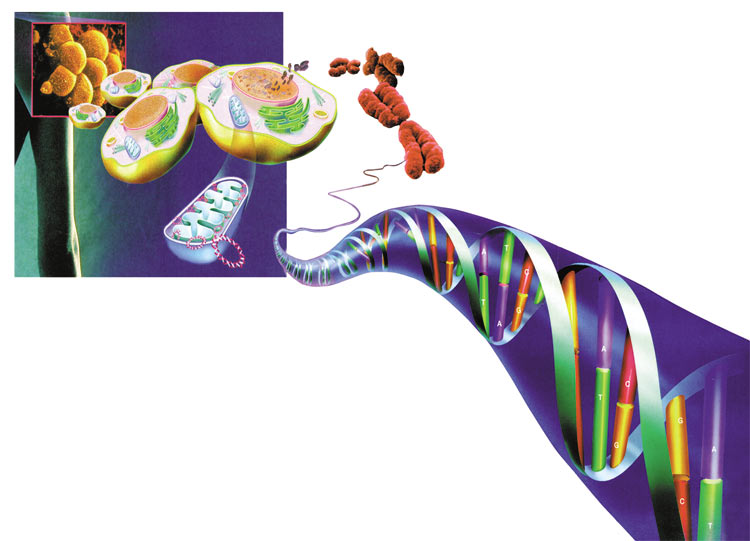 |
The body of information in DNA does not only determine the physical properties we have mentioned above; it also controls thousands of other operations and systems running in the cell and the body. For instance, even the highness, lowness, or normality of a person's blood pressure depends on the information stored in DNA.
The Huge Encyclopedia in the Human Cell
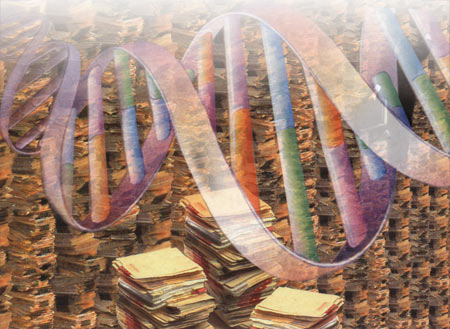
The information stored in DNA must by no means be underestimated. Though hard to believe, in a single DNA molecule of a human being, there is enough information to fill exactly one million encyclopedia pages. Do consider it; exactly 1,000,000 encyclopedia pages… This is to say that the nucleus of each cell contains so much information as to fill a one-million-page-encyclopedia, which is used to control the functions of the human body. To draw an analogy, we can state that even the 23-volume-Encyclopedia Britannica, one of the greatest encyclopedias of the world, has 25,000 pages. Therefore, before us lies an incredible picture. In a molecule found in a nucleus, which is far smaller than the microscopic cell wherein it is located, there exists a data warehouse 40 times bigger than the biggest encyclopedia of the world that includes millions of items of information. This means a 920-volume huge encyclopedia which is unique and has no equal in the world. Research puts it that this huge encyclopedia would be estimated to contain 5 billion different pieces of information. Were one piece of information present in human genes to be read every second, non-stop, around the clock, it would take 100 years before the process was completed. If we imagine that the information in DNA were put in the form of a book, then, these books put on top of each other would reach 70 meters high.
Let us repeat these two words just mentioned above; 'contain information'…
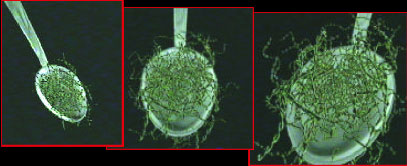
The information necessary to specify the design of all the species of organisms which have ever existed on the planet, a number of approximately one thousand million, could be held in a teaspoon and there would still be room left for all the information in every book ever written.
We should stop here and consider these two words which we pronounce so simply. It is simple to say that a cell contains billions of pieces of information. Yet, this is far away from being a detail that can be casually dropped as a remark. This is because what we talk about here is not a computer or a library, but just a cube that is 100 times smaller than a millimeter, simply made up of protein, fat and water molecules. It is an extremely amazing miracle for this infinitesimal piece of flesh to contain and store even a single bit of information-let alone millions of it.
In the modern era, people use computers to store information. The computer technology is today considered as the most advanced technology that paves the way to all other technologies. A body of information, which, 20 years ago, could be stored in a computer the size of a room, can today be stored in small "microchips", yet even the latest technology invented by human intelligence after centuries of accumulated knowledge and years of hard work is far from reaching the information storage capacity of a single cell nucleus. We think that the following comparison would be sufficient to give a sense of the smallness of DNA, which has such an immense capacity:
The information necessary to specify the design of all the species of organisms which have ever existed on the planet, a number according to G.G. Simpson of approximately one thousand million, could be held in a teaspoon and there would still be room left for all the information in every book ever written.1
How can a chain invisible to the eye, made up of atoms arranged sideways, with a diameter the size of a billionth of a millimeter, possess such an information capacity and memory? And also add the following to this question: While each one of the 100 trillion cells in your body knows one million pages of information by heart, how many encyclopedia pages can you, as an intelligent and conscious human being, memorize in your entire life?
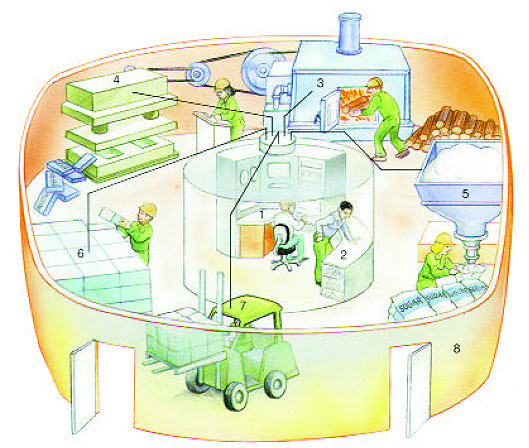
The cell resembles a big factory which contains conveyor systems, information storing centers, special compartments where chemical processes are made, energy generating power stations, and packaging centers. The only difference between the cell and such a factory is the cellÕs microscopic size.
The Wisdom in the Cell
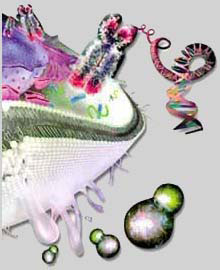
In this case, you must admit that any cell in your stomach or ear is much more learned than you, and since it makes use of this information in the most correct and perfect way, it is much more wise than you.
What, then, is the source of this wisdom? How come every one of the 100 trillion cells in your body has come to possess such an incredible wisdom? These are, after all, piles of atoms, and they are unconscious. Take the atoms of all the elements, combine them in different forms and numbers, obtain different molecules, still you can never obtain wisdom. Whether these molecules are big or small, simple or complex does not matter. You can never obtain a mind that will consciously organize any process and accomplish it.
Then how can it be that DNA, which is composed of the arrangement of a certain number of unwise and unconscious atoms in certain sequences, and enzymes, working in a harmonious way, is able to achieve much work and organise countless complicated and diverse operations in the cell in a perfect and complete manner? The answer to this is very simple; wisdom is not in these molecules or in the cell that contains them, but in the self who has brought these molecules into being, programming them to function as they do.
Shortly put, wisdom is present not in the work done, but in the creator of that work. Even the most developed computer is the product of a wisdom and intellect that has written and installed the programs to operate it, and then used it. Likewise, the cell, DNA and RNAs in it, and the human being made up of these cells are nothing but the works of the One Who created them as well as what they do. No matter how perfect, complete and striking the work is, the wisdom always lies with the owner of the work.
One day, if you found a diskette on the table in the computer laboratory, and after looking inside, discovered that it contains billions of items of information about you, the first question that would come to your mind would be who has written these pieces of information and why.
So, why don't we ask the same question for the cell? If the information in the diskette was written by someone, then by whom DNA, which has a much more superior and advanced technology, is designed in the most perfect manner, created, and placed in the tiny cell, which, by itself, is another miracle. Besides it has not lost any of its properties for thousands of years until our day. (Bear in mind that the brain of the human being who makes the diskette and saves the data in it, is also made up of these cells.) What can be more important for you than to question by whom and why these cells, that function non-stop for you to read these lines, see, breathe, think, in brief, to exist and continue to exist, have been brought into being?
Is not the answer to this question that which, in life, you must wonder about most?
A Few More Examples
It is a well-known method: the travellers, who get stuck in an isolated land as a result of a plane crash, draw a big 'X' to show their places to the rescue team that looks for them from the air. Using their belongings or the objects they have collected, they make a big cross-shaped sign. In this way the rescue team that sets out on reconnaissance from the air, sees this sign which is a 'product of wisdom' and understands that there are conscious living beings, that is, human beings in that place.
While travelling along on Turkish highways, you sometimes see inscriptions made of white stones on the slopes of the hills like; 'Everything is for the motherland'. How these writings have come to form on those hills is quite clear. In most cases, there is a military unit around and they write such inscriptions with white stones on the hill while clearing the zone.
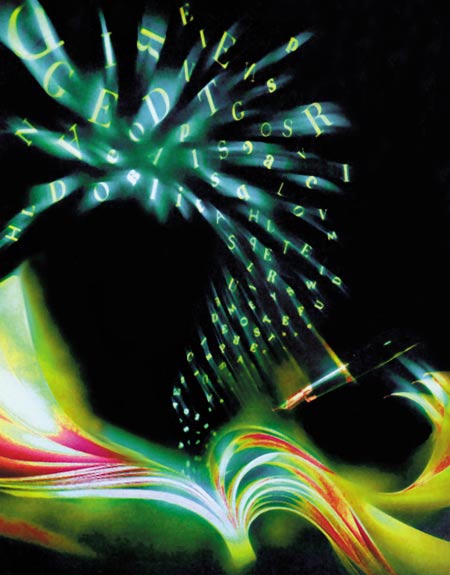
The complex structure of a living cell was unknown in Darwin's day and at the time, ascribing life to "coincidences and natural conditions" was thought by evolutionist to be convincing enough. However, the probability of the forma - tion of a cell by chance is as unlikely as the chance printing of a book caused by an explosion in a printing house. This means that it is not possible for the cell to come into being by coinci - dence and therefore, it definitely should have been "created".
Well, can anybody come up and say that these inscriptions are not written by a conscious mind, in this case the soldiers, and instead formed by coincidence? Can anybody say that 'these stones came side by side by chance while rolling down the hill and formed the sentence 'Everything is for the motherland'"?
Or if a 'scientist' comes up and says 'there are trillions of stones in the world and they have been rolling over for millions of years, so it is possible that some of these stones came together by coincidence as to make this meaningful sentence', would he not be ridiculed even by children? In addition to this, if he uses a scientific style, makes some scientific explanations, and puts forward some probability calculations, would everybody not further doubt about his mind?
The main idea we would like to give with these examples is this: If there is even the slightest sign of something planned somewhere, there certainly lies the traces of an owner of wisdom in that place. No product of wisdom would form by chance. If you roll white stones down the mountain billions of times, you would never obtain even a proper 'H', let alone a sentence such as "Everything is for the motherland". If there is a letter somewhere, everybody accepts that that letter is written by somebody. There would be no letter without a writer.
The human body is trillions of times more complicated than the sentence 'Everything is for the motherland', and it is definitely impossible for this complex structure to have been formed on its own, or by sheer "coincidence". Therefore, there is a Creator Who has planned and designed both the human and his cell and his DNA excellently and perfectly. To claim the contrary would be the most unwise thing possible, and moreover a greatest insincerity and insolence. This would be a great disrespect against the owner of that wisdom and power.
Nevertheless, many people, who would readily say that it is impossible for stones to be arranged within themselves and form even three little words, can listen without objection the deceit that it was all as a result of "coincidences" that billions of atoms came together one by one in a planned sequence and formed a molecule such as DNA, which performs such a super-complex task. This is just like a hypnotized person's submitting to the hypnotist and accepting by suggestion that he is a door, tree or a lizard…
The Language of the DNA Encyclopedia
The life of societies is based on information flow, and communication. The most important tool in the information flow between individuals and generations is language. Language is represented by specific codes, which are letters. English is a language made up of 26 letters or we may say 26 codes. These codes make up words and words in turn make up sentences. The information flow and storage is realised by means of these codes.
The language in the cell is similar to this. All the physical traits of a human being are stored in the cell nucleus being coded by this language, and it can be used by the cell again by way of this language. This language is that of the master molecule, called DNA. The DNA language is made up of 4 letters; A, T, G and C. Every letter represents one of the four special bases called 'nucleotides'. Millions of these bases line up in a meaningful sequence and make up the DNA molecule.

That is how the information in the data bank in the nucleus is stored. While we describe the coding system in this data warehouse, we will continue to use this letter analogy for the nucleic acid molecules which constitute DNA. These letters match in twos each forming a base pair in this way. These base pairs add on top of each other to form the genes. Each gene, which comprises one portion of DNA molecule, determines a particular feature of the human body. Countless properties like height, eye colour, the material and the shape of the nose, ear, and skull are formed by the command of the related genes. We can compare every one of these genes to the pages of a book. On the pages there are scripts made up of the letters A – T – G – C.
There are approximately 200,000 genes in the DNA of a human cell. Every gene is composed of a special sequence of nucleotides, the number of which ranges between 1000 and 186,000 according to the type of the protein it correlates. These genes hold the codes of nearly 200,000 proteins that function in the human body and control the production of these proteins.
The information stored in these 200,000 genes constitute only 3 % of the total information in DNA. The remaining 97 % still maintains its mystery today. The recent studies showed that this 97 % unknown part includes vital information about the survival of the cell and the mechanisms that control the highly complex activities within the body. Yet there is still a great distance to go.
The genes are located in the chromosomes. There are 46 chromosomes in the nucleus of every human cell (except for the reproduction cells). If we compare every one of the chromosomes to a book volume made up of gene pages, we may say that in the cell lies a 46-volume "cell encyclopedia" which covers all the characteristics of a human being. Remembering the previous encyclopedia example, this cell encyclopedia is equivalent to the knowledge contained in a 920-volume 'Encyclopedia Britannica'.
The sequence of letters in the DNA of every human is different. This is the basic reason why the billions of people who have ever lived on earth look different from each other. The basic structure and functions of organs are the same in every person. However, every person is created in such a detailed and special manner with such subtle differences that even though all people are created from the division of a single cell and have the same basic structure, billions of different people have come into existence.
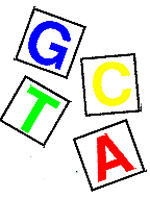
All the organs in our body are constructed within a plan outlined by our genes. To give a few examples, according to a gene map completed by scientists, in the human body, skin is controlled by 2,559, brain by 29,930, eye by 1,794, salivary glands by 186, heart by 6,216, chest by 4,001, lung by 11,581, liver by 2,309, intestine by 3,838, skeletal muscle by 1,911 and blood cells by 22,902 genes.
The sequential order of the letters in DNA determines the structure of a human being down to his slightest details. In addition to features like height, eye, hair and skin colours, the DNA of a single cell also contains the design of 206 bones, 600 muscles, a network of 10.000 auditory muscles, a network of 2 million optic nerves, 100 billion nerve cells, and 100 trillion cells in the body.
Now let us think in the light of the above information: Since even a letter cannot form without a writer writing it, how did billions of letters in the human cell originate? How did these letters queue up in a meaningful sequence so as to make up the unique plan of such a perfect and complex body? If there were any break downs in the order of these letters you could have your ear on your abdomen or your eyes in your heels. You could have born with your hands stuck on your back, and lived as a freak. The secret of your living as a proper human currently lies in the 'flawless' sequence of the billions of letters in the 46-volume encyclopedia in your DNA.
DNA Challenges Coincidence
Today mathematics has proved that coincidence does not play a role in the formation of the coded information within DNA, let alone the DNA molecule made up of millions of base pairs. The probability of the coincidental formation of even a single gene out of the 200,000 genes making up DNA is so low that even the notion of impossible remains weak. Frank Salisbury, an evolutionist biologist, makes the following statement about this 'impossibility':

Everyone in the world is unique - biochemically and pysically - thanks to a wondrous molecule (DNA), which includes a threebillion word set of biochemical instructions for building a human from scratch.
A medium protein might include about 300 amino acids. The DNA gene controlling this would have about 1,000 nucleotides in its chain. Since there are four kinds of nucleotides in a DNA chain, one consisting of 1,000 links could exist in 41000 forms. Using a little algebra (logarithms) we can see that 41000=10600. Ten multiplied by itself 600 times gives the figure 1 followed by 600 zeros! This number is completely beyond our comprehension.2
That is to say that even if we assume that all the necessary nucleotides are present in a medium, and that all the complex molecules and enzymes to combine them were available, the possibility of the these nucleotides being arranged in the desired sequence is 1 in 41000, in other words, 1 in 10600. Briefly, the probability of the coincidental formation of the code of an average protein in the human body in DNA by itself is 1 in 1 followed by 600 zeros. This number, which is beyond even being astronomical, means in practice 'zero' probability. This means that such a sequence has to be effected under the control and knowledge of a wise and conscious power. There is zero probability of it happening by 'accident', 'chance', or 'coincidence'.
Think of the book you are reading right now. How would you regard someone who claimed that letters (by using a different printing stamp for every letter) have come together by chance on their own to form this writing? It is evident that it was written by an intelligent and conscious person. This is no different from the status of DNA.
Francis Crick, the biochemist who discovered the structure of DNA, won a Nobel prize with respect to the research he had made on the subject. Crick, who was an ardent evolutionist, stated the following scientific opinion in a book he has written after testifying the miraculous structure of DNA: "An honest man, armed with all the knowledge available to us now, could only state that, in some sense, the origin of life appears at the moment to be almost a miracle."3 Even in Crick's view, who was one of the biggest experts on DNA, life could never originate on earth spontaneously.
The data in DNA, which is made up of 5 billion letters, is composed of a special and meaningful sequence of letters A-T-G-C. However, not even a single letter error should be made in this sequence. A misspelled word or a letter error in an encyclopedia may be overlooked and ignored. It would not even be noticed. However, even a single mistake in any base pair of DNA, such as a miscoded letter in the 1 billion 719 million 348 thousand 632nd base pair, would cause terrible results for the cell, and therefore for the person himself. For instance, haemophilia (child leukemia) is the outcome of such an erroneous coding.
In truth, it would be incorrect to call this "erroneous coding", because like every other thing that exists, the human DNA, too, is created by God and even the seldom occurring mistakes come about with respect to a hidden cause (divine purpose). The coding mistake which causes cancer is a specially created disorder. It is created specially for a certain hidden cause to show man his own weakness and impotence, remind him of the delicate balances man's creation depends on, and of what kind of troubles he may face in case of the slightest disturbance in these balances.
The probability of the coincidental formation of the code of an average protein
in the human body in the DNA by itself is 1 in 10600. We can write this number
which is formed by putting 600 zeros next to 1 as follows:
10600 =
1,000,000,000,000,000,000,000,000,000,000,000,000,000,000,000,000,000,000,000,000,
000,000,000,000,000,000,000,000,000,000,000,000,000,000,000,000,000,000,000,000,
000,000,000,000,000,000,000,000,000,000,000,000,000,000,000,000,000,000,000,000,
000,000,000,000,000,000,000,000,000,000,000,000,000,000,000,000,000,000,000,000,
000,000,000,000,000,000,000,000,000,000,000,000,000,000,000,000,000,000,000,000,
000,000,000,000,000,000,000,000,000,000,000,000,000,000,000,000,000,000,000,000,
000,000,000,000,000,000,000,000,000,000,000,000,000,000,000,000,000,000,000,000,
000,000,000,000,000,000,000,000,000,000,000,000,000,000,000,000,000,000,000,000,
000,000,000,000,000,000,000,000,000,000,000,000,000,000,000,000,000,000,000,000,
000,000,000,000,000,000,000,000,000,000,000,000,000,000,000,000,000,000,000,000
Self-Replication of DNA
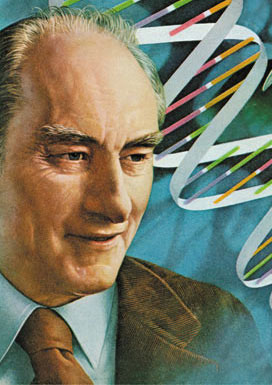
Francis Crick
As known, cells multiply by dividing. While the human body is initially composed of a single cell, this cell divides and reproduces by folds with a ratio of 2-4-8-16-32...
What happens to DNA at the end of this dividing process? There is only one DNA chain in the cell. However, it is evident that the newly formed cell will also require a DNA. In order to fill this gap, DNA completes an interesting series of operations, every phase of which is a different miracle. Finally, soon before the cell divides, it makes a copy of itself and transfers this to the new cell.
The observations regarding the cell division show that the cell has to reach a specific size before dividing. The moment it exceeds this particular size, the division process automatically starts. While the shape of the cell begins to get smoother so as to accommodate the division process, DNA starts to replicate itself as mentioned earlier.
This means that the cell 'decides' to divide as a whole and the different parts of the cell start to act in accordance to this decision of dividing. It is evident that the cell is devoid of the consciousness to accomplish such a collective action. The division process starts with a secret order and the entire cell, foremost DNA, acts by this order.
First, DNA divides into two to replicate itself. This event takes place in a very interesting manner. The DNA molecule which resembles a spiral ladder divides into two like a zip from the middle of the rungs of the ladder. From now on, DNA divides into two portions. The missing halves (replicates) of both of the two portions are completed with the materials present in the milieu. In this way, two new DNA molecules are produced. In every phase of the operation, expert proteins called "enzymes" that function like advanced robots take part. Though it seems simple at first sight, the intermediary processes taking place throughout this operation are so many and so complicated that to describe the whole event in detail would take pages.
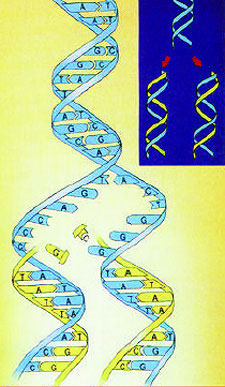
The DNA molecule shown here is in the process of replication, separating down the middle. When strands sepa rate, each attracts base pairs in the same sequence carried by its opposite half.
The new DNA molecules that emerge during replication are checked repeatedly by inspector enzymes. If there is any mistake done - which can be quite vital, it is immediately identified and corrected. The erroneous code is removed and replaced by the correct one. All these processes take place at such a dazzling speed that while 3.000 base pairs are produced in a minute, on the other hand, all these pairs are checked repeatedly by the enzymes in charge and the necessary amendments are made.
In the newly produced DNA molecule, more mistakes can be done than normal as a result of external factors. In this case, the ribosomes in the cell start to produce DNA repair enzymes upon the order given by DNA. Thus, as DNA protects itself, it also guarantees the preservation of the generation.
The cells are born, they reproduce and die just like human beings. Yet the life spans of cells are much shorter than the life of the human they constitute. For instance, the majority of the cells that used to make up your body six months ago do not exist today. However, you are now able to survive because they have divided on time to leave their places to the new ones. For this reason, highly complex operations like multiplication of the cells and replication of DNA are vital processes which cannot tolerate even a minor mistake in regards to man's survival. However, the multiplication process runs so smoothly that the rate of error is only one in 3 billion base pairs. And this one error is eliminated by the higher control mechanisms in the body without causing any problems.
All through the day, while you are unaware, numerous operations and controls are made, many measures are taken in your body in an incredibly fastidious and responsible manner for you to lead your life without any problem. Every single thing carries out its duty successfully and completely. God has given to your service countless atoms and molecules, from the biggest to the smallest, from the simplest to the most complex, so that you may live a good and healthy life. Is even this blessing and favour alone not sufficient for you to give thanks? Or should one always wait for problems to occur in this perfect system before coming to one's senses?
The most interesting point is that these enzymes which help the production of DNA and control its composition are actually proteins produced according to the information coded in DNA and under the command and control of DNA. There is such an intertwined, perfect system at work that it is by no means possible for such a system to have attained this state by gradual coincidences. Just as DNA has to exist for the enzyme to exist, so the enzyme has to exist for DNA to exist, and for both to exist, on the other hand, the cell has to exist completely, down to its membrane and all other complex organelles it contains.
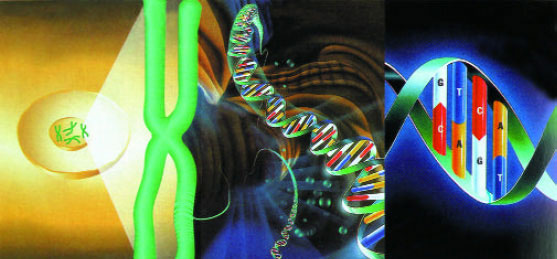
The theory of evolution asserting that living beings evolved 'step by step' as a result of 'beneficial coincidences' is explicitly refuted by the above mentioned DNA-enzyme paradox. This is because both DNA and the enzyme have to exist at the same time. And this shows the existence of a conscious Creator, that is, God.
Evolutionists Cannot Explain How the Information in DNA Originated and How It Differs in Every Species
While evolutionists can in no way bring any explanation to the subject of how DNA originated, there is yet another point where they reach an impasse. How come fish, reptiles, birds, human beings etc. have come to possess different DNAs and different types of information?
Evolutionists answer that question by saying that the body of information in DNA developed and diversified over time by means of coincidences. The coincidences they refer to are "mutations". Mutations are changes which take place in DNA as a result of radiation or chemical action. Sometimes radioactive radiation happens to fall on a DNA chain and destroys or displaces several base pairs therein. According to evolutionists, living things have reached their present perfect state as a result of the diversification of a single DNA due to these mutations (i.e., accidents).
To show that this claim is unreasonable, let us compare DNA to a book again. We have already mentioned that DNA is made up of letters lined up sideways just like in a book. Mutations are like the letter errors that occur during the type-setting of this book. If you like, we can do an experiment on this subject. Let us ask for a thick book about the history of the world to be type-set. During the type-setting, let us intervene several times and tell the type-setter to press one of keys blindfolded and at random. Then let us give this text containing letter errors to someone else and have him do the same thing over again. Using this method, let us have the book type-set from the beginning to the end several times, thus having a few more letter errors added to it at random each time...
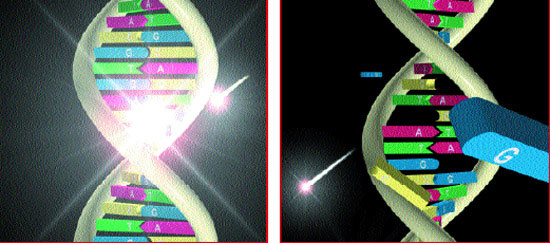
Mutations are defined as breaks or replacements taking place in the DNA molecule. These breaks or replacements are the result of external effects such as radiation or chemical action. Every mutation is an "accident" and either damages the nucleotides making up the DNA or changes their locations
Could this history book ever develop by this method? For instance, would an additional chapter named "The History of Ancient China", which previously was not present, emerge?
To be sure, the letter errors we have added to the book would not develop it, but rather ruin it and distort its meaning. The more we increase the number of faulty copying processes, the more spoiled our book will be.
Yet the claim of the theory of evolution is that "letter errors help develop a book". According to evolution, mutations (errors) occurring in DNA have led to beneficial results by accumulating and thus furnishing living beings with perfect organs such as eyes, ears, wings, hands and consciousness-related qualities such as thinking, learning, and reasoning.
Unquestionably, this claim is even more unreasonable than the above example of the addition of the chapter called "The History of Ancient China" to a book on world history as a result of the accumulation of letter errors. (Moreover there is no mechanism in nature that causes regular mutations as in the example of the type-setter making regular mistakes. The mutations in nature take place much more rarely than the letter errors that would occur during the type-setting of a book.)
Every "explanation" put forward by the theory of evolution on the origin of life is unreasonable and unscientific. One outspoken authority on this issue is the famous French zoologist Pierre Grassé, the former president of the French Academy of Sciences. Grassé is also an evolutionist, but he states clearly that Darwinist theory is unable to explain life and makes his point about the logic of "coincidence", which is the backbone of Darwinism:
The opportune appearance of mutations permitting animals and plants to meet their needs seems hard to believe. Yet the Darwinian theory is even more demanding: A single plant, a single animal would require thousands and thousands of lucky, appropriate events. Thus, miracles would become the rule: events with an infinitesimal probability could not fail to occur… There is no law against daydreaming, but science must not indulge in it.4

Eye
Leg
Antenna
Far left: A normal fruit fly (drosophila) Left: A fruit fly with its legs jutting from its head; a mutation induced by radiation.
Indeed, the theory of evolution, which claims that inorganic matter came together by itself and formed living beings with such glorious systems as DNA, is a scenario totally contrary to science and reason. All this leads us to an evident conclusion. Since life has a plan (DNA) and all living beings are fashioned according to this plan, it is evident that there is a superior Creator Who devised this plan. This simply means that all living beings are created by God, the All-Powerful, All-Wise. God states this fact in the Qur'an in this way:
He is God – the Creator, the Maker, the Giver of Form. To Him belong the Most Beautiful Names. Everything in the heavens and earth glorifies Him. He is the Almighty, the All-Wise. (Surat al-Hashr: 24)
Today, what people have achieved by means of technology can at best be described as 'an approach to the understanding of a tiny fragment of God's knowledge, as manifested in human DNA.'
On the other hand, the theory of evolution which tries to explain the origin of life as a series of coincidences loses all validity in face of the question: "How then, did DNA originate?"
NOTES
1 Michael Denton, Evolution:A Theory in Crisis, London: Burnett Books, 1985, p. 334. ![]()
2 Frank B. Salisbury, "Doubts about the Modern Synthetic Theory of Evolution", American Biology Teacher, September 1971, p. 336. ![]()
3 Francis Crick, Life Itself: It's Origin and Nature, New York, Simon & Schuster, 1981, p. 88. ![]()
4 Pierre-P Grassé, Evolution of Living Organisms, New York: Academic Press, 1977, p. 103. ![]()
